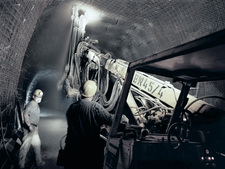Konrad's suitability to host a repository
In a depth of 800 to 1,300 metres of the Konrad mine there are iron ore deposits where one intends to dispose of the radioactive waste. Compared with other iron ore mines, Konrad is exceptionally dry. The covering layer of clay rocks, which is 160 to 400 m thick, seals the mine against the groundwater near the surface and the Salzgitter branch canal.
Between 1975 and 1982, the former Gesellschaft für Strahlen- und Umweltforschung (today: Helmholtz Zentrum München) conducted comprehensive analyses and evaluations as to the geology, hydrogeology, rock mechanics, seismology and the safety of the repository.

![]() Mobile driller boring holes for fixing strata bolts in preparation for the storage roadway
Mobile driller boring holes for fixing strata bolts in preparation for the storage roadway
Anifold analyses
The analyses covered the hydrochemical conditions of the aquifers and the hydrological conditions. Furthermore, the features of the different rock layers as migration barriers for radionuclides were examined with regard to permeability and sorption behaviour, the rock-mechanical conditions near the emplacement chambers, emplacement fields and the entire mine openings, and the seismic stability of the site.
On account of the favourable geological conditions, the thick, large, clay layers above the emplacement fields, no radionuclides from the emplacement area can reach the biosphere.
Isolation of the waste for as long as possible
The Konrad repository corresponds to the requirements of the Working Group for the Selection of Repository Sites (AkEnd) in terms of the isolating rock zone. This is the part of the geological barriers which, given a normal development of the repository and in combination with technical and geotechnical barriers, must ensure the enclosure of the waste as long an possible in order to protect man and environment.
State of 2017.03.27

